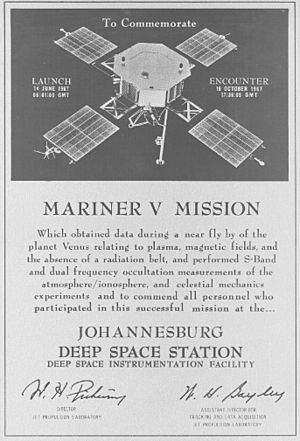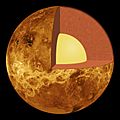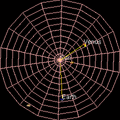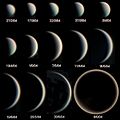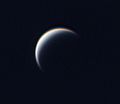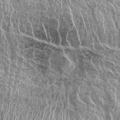Venus facts for kids
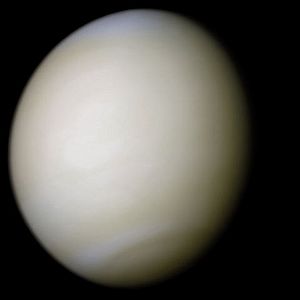
A real-colour image taken by Mariner 10 processed from two filters, the surface is obscured by thick sulfuric acid clouds
|
|||||||||||||||||
| Designations | |||||||||||||||||
|---|---|---|---|---|---|---|---|---|---|---|---|---|---|---|---|---|---|
| Adjectives | Venusian or (rarely) Cytherean, Venerean | ||||||||||||||||
| Orbital characteristics | |||||||||||||||||
| Known satellites | None | ||||||||||||||||
| Physical characteristics | |||||||||||||||||
|
Mean radius
|
|
||||||||||||||||
|
|||||||||||||||||
| Volume |
|
||||||||||||||||
| Mass |
|
||||||||||||||||
|
Mean density
|
5.243 g/cm3 | ||||||||||||||||
|
|||||||||||||||||
|
|||||||||||||||||
| Atmosphere | |||||||||||||||||
|
Surface pressure
|
92 bar (9.2 MPa) | ||||||||||||||||
| Composition by volume |
|
||||||||||||||||
Venus is the second planet from the sun. It has a day longer than a year. The year length of Venus is 225 Earth days. The day length of Venus is 243 Earth days. On Venus, the sun rises every 117 Earth days. That means the sun only rises two times during each year on Venus!
It is a terrestrial planet because it has a solid, rocky surface like other planets in the inner solar system. Astronomers have known Venus for thousands of years. The ancient Romans named it after their goddess Venus. Venus is the brightest thing in the night sky except for the Moon. It is sometimes called the morning star or the evening star as at some elongations it is easily seen just before the sun comes up in the morning and, at other times, just after the sun goes down in the evening. Venus comes closer to the Earth than any other planet does. A Venusian day takes about 243 Earth days.
Venus is sometimes called the sister planet of Earth as they are quite similar in size and gravity. In other ways the planets are very different. Venus' atmosphere (air) is mostly carbon dioxide with clouds of sulphuric acid. Sulphuric acid is a chemical that is very poisonous to humans.
The thick atmosphere has made it hard to see the surface, and until the twenty-first century many people thought things might live there. The pressure on Venus' surface is 92 times that of Earth. Venus has no moons. Venus spins very slowly on its axis and it spins in the opposite direction to the other planets.
Contents
Physical properties
Venus is a terrestrial planet so, like the Earth, its surface is made of rock. Venus is much hotter than Earth. All the carbon dioxide in the atmosphere acts like a blanket, trapping heat from the Sun. This effect is called the greenhouse effect and it is very strong on Venus. This makes the surface of Venus the hottest of any planet's surface in the Solar System with an estimated average temperature of 480 °C (896.0 °F). This is hot enough to melt lead or zinc.
Geography
Venus has no oceans because it is much too hot for water. Venus' surface is a dry desert. Because of the clouds, only radar can map the surface. It is about 80% smooth, rocky plains, made mostly of basalt. Two higher areas called continents make up the north and south of the planet. The north is called Ishtar Terra and the south is called Aphrodite Terra. They are named after the Babylonian and Greek goddesses of love.
The surface of Venus looks like it has been shaped by volcanic activity. Venus has a lots of volcanoes. The surface of Venus is estimated to be 300–600 million years old.
Atmosphere
Venus' atmosphere is mostly carbon dioxide and nitrogen gas with clouds of sulphuric acid. Because the atmosphere is so thick or dense the pressure is very high. The pressure is 92 times the pressure on Earth, enough to crush many things.
It is impossible to see the planet's surface from space as the thick cloud layer reflects 60% of the light that hits it. The only way scientists are able to see it is by using infrared and ultraviolet cameras and radar.
Scientists believe that billions of years ago, the atmosphere of Venus could have been like Earth's atmosphere. There may have been lots of water on the surface of Venus. But after 600 million to several billion years, a greenhouse effect was caused by the evaporation of the water, which made lots of greenhouse gases in its atmosphere.
Magnetic field
In 1967, Venera 4 found that the magnetic field of Venus was much weaker than that of Earth. This magnetic field is induced by an interaction between the ionosphere and the solar wind. Venus' magnetosphere is not strong enough to protect the atmosphere from cosmic rays.
Transit of Venus
Venus can sometimes be seen passing between the Sun and Earth. Venus looks like a black dot when seen through a special telescope. These passages are called "transits". These "transits" happen in pairs eight years apart. Then it is more than a hundred years to the next pair.
Orbit and rotation
Venus orbits the Sun at an average distance of about 108 million km (67 million mi). It completes an orbit every 224.7 days. The rotation of Venus is slow. A Venusian day is longer than a Venusian year.
Exploration
The first robotic space probe mission to Venus, and the first to any planet, began with the Soviet Venera program in 1961. The United States' exploration of Venus had its first success with the Mariner 2 mission on 14 December 1962, becoming the world's first successful interplanetary mission, passing 34,833 km (21,644 mi) above the surface of Venus, and gathering data on the planet's atmosphere.
On 18 October 1967, the Soviet Venera 4 successfully entered the atmosphere and deployed science experiments. Venera 4 showed the surface temperature was hotter than Mariner 2 had calculated, at almost 500 °C (932 °F), determined that the atmosphere is 95% carbon dioxide (CO2), and discovered that Venus's atmosphere was considerably denser than Venera 4's designers had anticipated. The joint Venera 4–Mariner 5 data were analysed by a combined Soviet–American science team over the following year, in an early example of space cooperation.
Venera 7, the first space probe to land on Venus, was destroyed by the hostile conditions on Venus after only 23 minutes. In 1974, Mariner 10 swung by Venus on its way to Mercury and took ultraviolet photographs of the clouds, revealing the extraordinarily high wind speeds in the Venusian atmosphere.
In 1975, the Soviet Venera 9 and 10 landers transmitted the first images from the surface of Venus, which were in black and white. In 1982 the first colour images of the surface were obtained with the Soviet Venera 13 and 14 landers.
NASA obtained additional data in 1978 with the Pioneer Venus project that consisted of two separate missions: Pioneer Venus Orbiter and Pioneer Venus Multiprobe. The successful Soviet Venera program came to a close in October 1983, when Venera 15 and 16 were placed in orbit to conduct detailed mapping of 25% of Venus's terrain.
Several other Venus flybys took place in the 1980s and 1990s that increased the understanding of Venus, including Vega 1 (1985), Vega 2 (1985), Galileo (1990), Magellan (1994), Cassini–Huygens (1998), and MESSENGER (2006).
Then, Venus Express by the European Space Agency (ESA) entered orbit around Venus in April 2006. Equipped with seven scientific instruments, Venus Express provided unprecedented long-term observation of Venus's atmosphere. ESA concluded that mission in December 2014.
As of 2016, Japan's Akatsuki is in a highly elliptical orbit around Venus since 7 December 2015, and there are several probing proposals under study by Roscosmos, NASA, and India's ISRO.
In 2016, the NASA Innovative Advanced Concepts program studied a rover, the Automaton Rover for Extreme Environments, designed to survive for an extended time in Venus' environmental conditions. It would be controlled by a mechanical computer and driven by wind power.
Related pages
Images for kids
-
Size comparison with Earth
-
Impact craters on the surface of Venus (false-colour image reconstructed from radar data)
-
Global view of Venus in ultraviolet light done by Mariner 10
See also
 In Spanish: Venus (planeta) para niños
In Spanish: Venus (planeta) para niños





